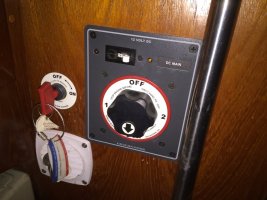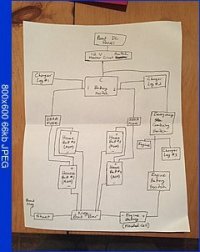So the previous owner of our new E35-3 did some rather interesting electrical work. Not interesting in quality, that seems pretty good. But interesting in choices. I have included a basic schematic of the electrical system as I understand it right now. As well as a few current pictures of locations of things.
In general I am trying to wrestle with the idea of if I want to continue using his method of two individual or isolatable house banks. From talking with him he always ran them in “both” so typically it acted as one big bank. However the choice of having two banks as currently installed has a lot of issues with charging unless your primary method is through shore power (which is how I believe he did it, I found a inverter-generator manual onboard and think the boat was at a marina in general).
As currently wired when the engine is running only the engine battery gets charged unless you turn on the “emergency bonding” switch. If your bank is way down on charge linking a mostly charged engine start battery seems like a bad idea.
Also, the engine battery is a flooded battery but the house batteries are AGM. The charger (which has three channels) is set to AGM. It is a Xantrex truecharge 40 but it can’t be set for different chemistries per channel. So I believe this chronically undercharges the flooded cell.
Finally my biggest concern is that this summer I want to add some solar to the boat since we will be keeping it on a mooring.
I think I have a few options to make this work.
1. I can put a battery combiner between the engine battery and bank #1 and another one between #1 and #2 (the banks are not physically separated). Then the engine and future solar charge the engine battery and house bank. No other wiring changes required.
2. Connect the future solar to the common on the 1-2-both switch and then never turn that switch off. If it did get bumped by accident then I think I might ruin a solar controller, so that in my mind is less than ideal. I haven’t seen any solar controllers that will charge two banks either. Or those are probably expensive. On this method the engine battery would need a charge combiner and the engine wouldn’t charge the house except if combined as stated above.
3. No longer use the 1-2-both switch. Change the house bank to one big bank. Then I can charge either the house or the engine with solar and link with a charge combiner.
Random musings....
The current Blue Sea Systems DC panel has a shunt on the negative but this is reading all batteries. Can I put a separate shunt for the house batteries in place to run a battery monitor off of? I don’t know if multiple shunts causes problems. I wouldn’t think so...
Is there any real merit to the two bank house idea?
Was this the original location of the 1-2-both switch on E35-3’s and the PO repurposed it?
I probably want to change the engine battery to AGM, or I should get a different shore power charger?
Looking forward to input!
picture 1 is the electrical diagram. Picture two is the main breaker with the 1-2-both switch and “emergency” switch on the left.
In general I am trying to wrestle with the idea of if I want to continue using his method of two individual or isolatable house banks. From talking with him he always ran them in “both” so typically it acted as one big bank. However the choice of having two banks as currently installed has a lot of issues with charging unless your primary method is through shore power (which is how I believe he did it, I found a inverter-generator manual onboard and think the boat was at a marina in general).
As currently wired when the engine is running only the engine battery gets charged unless you turn on the “emergency bonding” switch. If your bank is way down on charge linking a mostly charged engine start battery seems like a bad idea.
Also, the engine battery is a flooded battery but the house batteries are AGM. The charger (which has three channels) is set to AGM. It is a Xantrex truecharge 40 but it can’t be set for different chemistries per channel. So I believe this chronically undercharges the flooded cell.
Finally my biggest concern is that this summer I want to add some solar to the boat since we will be keeping it on a mooring.
I think I have a few options to make this work.
1. I can put a battery combiner between the engine battery and bank #1 and another one between #1 and #2 (the banks are not physically separated). Then the engine and future solar charge the engine battery and house bank. No other wiring changes required.
2. Connect the future solar to the common on the 1-2-both switch and then never turn that switch off. If it did get bumped by accident then I think I might ruin a solar controller, so that in my mind is less than ideal. I haven’t seen any solar controllers that will charge two banks either. Or those are probably expensive. On this method the engine battery would need a charge combiner and the engine wouldn’t charge the house except if combined as stated above.
3. No longer use the 1-2-both switch. Change the house bank to one big bank. Then I can charge either the house or the engine with solar and link with a charge combiner.
Random musings....
The current Blue Sea Systems DC panel has a shunt on the negative but this is reading all batteries. Can I put a separate shunt for the house batteries in place to run a battery monitor off of? I don’t know if multiple shunts causes problems. I wouldn’t think so...
Is there any real merit to the two bank house idea?
Was this the original location of the 1-2-both switch on E35-3’s and the PO repurposed it?
I probably want to change the engine battery to AGM, or I should get a different shore power charger?
Looking forward to input!
picture 1 is the electrical diagram. Picture two is the main breaker with the 1-2-both switch and “emergency” switch on the left.
Attachments
Last edited:


